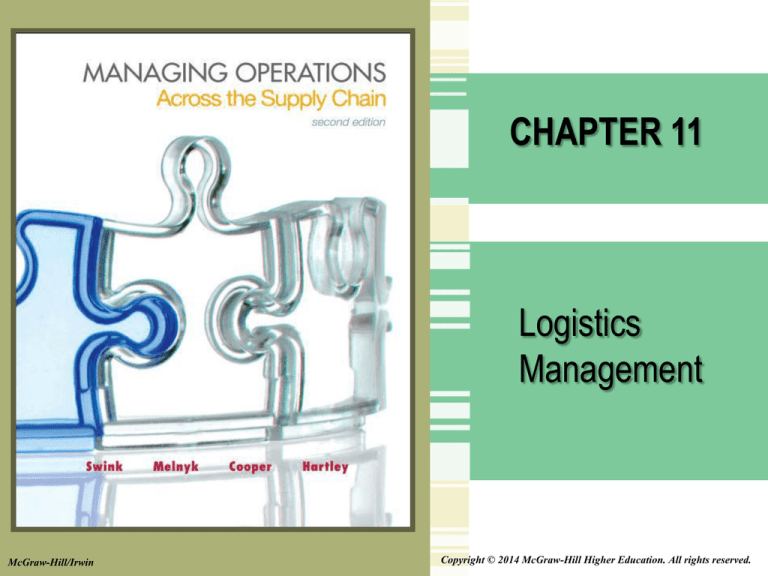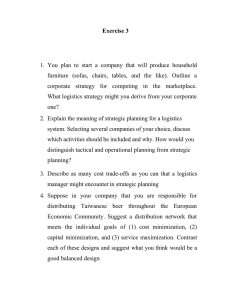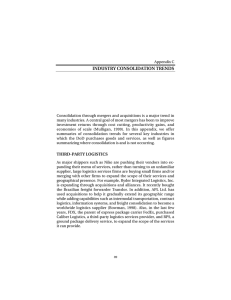
CHAPTER 11
Logistics
Management
McGraw-Hill/Irwin
Copyright © 2014 McGraw-Hill Higher Education. All rights reserved.
Learning Objectives
LO11-1 Explain logistics and major managerial
decisions
LO11-2 Estimate impact of consolidation on cost
LO11-3 Describe the mode and carrier selection
process
LO11-4 Explain roles and activities of warehousing,
distribution, and facility networks
LO11-5 Explain importance of packaging and materials
handling
LO11-6 Explain network design decisions using the
center-of-gravity model
LO11-7 Describe benefits of integrated service
providers
11–2
Logistics Management
Logistics Management: movement and storage
of materials to meet customer needs and
organizational objectives
• Includes forward and reverse flow
• Includes flow of materials and information
• Load, offload, move, sort and select
material
LO11-1
11–3
Logistics Cost Minimization &
Trade-offs
• Cost-to-Service:
• Cost-to-Cost:
another
service levels =
cost of one activity,
costs
of
• Total Landed Cost: sum of all product and
logistics related costs
- Country costs of manufacturing
- Cost in transit to country of sale
- Cost within country of sale
LO11-1
11–4
Transportation Management
Government’s Role:
• Economic Regulation: entry of new carriers,
rates and services provided
• Safety Regulation: safe for carriers and public,
including increased emphasis on security from
terrorist activity
LO11-1
11–5
Transportation Management
Transportation Economics:
• Economy of Scale: cost per unit of weight
decreases as shipment size increases
• Economy of Distance: cost per unit traveled
decreases as distance moved increases
Cost
Per
Unit of
Distance
Cost
Per
Unit of
Weight
Weight of Shipment
LO11-2
Distance
11–6
Consolidation
Consolidation: one large shipment made of
many smaller shipments
• By Market Area: combine small shipments
from one shipper going to the same area
• Pooled Delivery: combine small shipments
from different shippers going to the same area
• Scheduled Delivery: delivery at specific times
LO11-2
11–7
Transportation Mode Selection
In order to decide which mode of transportation
to use to ship an order, consider:
•
•
•
•
•
LO11-3
Speed
Availability
Dependability
Capability
Frequency
11–8
Carrier Types
Value Density: ratio of value to weight,
often determines the type of carrier used
• Common: provide service to the public with
published rates
• Contract: provide service only to select,
contracted customers
• Private: firm owns its own equipment
LO11-3
11–9
Warehouse Management – Part I
Break-Bulk
Consolidation
Cross-Docking
LO11-4
11–10
Warehouse Management – Part II
• Reverse Logistics:
- Material moves upstream in the supply
chain
- Especially important in online retail
(www.zappos.com)
• Value Added Services: providing additional
value to the customer, such as
postponement
LO11-4
11–11
Materials Handling and Packaging
• Handling material increases costs and risk of
damage
• Packaging can decrease handling costs and
risk of damage
- Containerization or Unitization: filling or
creating a larger container from smaller ones
- Automated Storage and Retrieval
Systems: robots that get, move and putaway material
LO11-5
- RIFD: electronic tracking of material
11–12
Network Design
• Most impact on supply chain operations
• Multiple factors to consider
–Labor
–Proximity to suppliers and customers
–Cost of land and construction
–Taxes, incentives and regulations
–Infrastructure
–Quality of life for employees
LO11-6
11–13
Integrated Service Providers
• Integrated service providers (ISPs):
Companies that provide a range of
logistics services.
• Third-party logistics service providers
(3PLs): A common term used in the
industry to describe ISPs.
LO11-7
11–14
Logistics Management Summary
1. Flow of material and information between
suppliers, producers and customers
2. Meet customer needs at lowest landed cost
3. Includes multiple decision areas
4. Economies of scale and distance impact costs
5. Multiple warehouse type to facilitate material
storage and flow
6. Network design and facility location impact
costs and customer service
11–15












